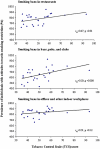Smoking behaviour, involuntary smoking, attitudes towards smoke-free legislations, and tobacco control activities in the European Union
- PMID: 21079729
- PMCID: PMC2975630
- DOI: 10.1371/journal.pone.0013881
Smoking behaviour, involuntary smoking, attitudes towards smoke-free legislations, and tobacco control activities in the European Union
Abstract
Background: The six most important cost-effective policies on tobacco control can be measured by the Tobacco Control Scale (TCS). The objective of our study was to describe the correlation between the TCS and smoking prevalence, self-reported exposure to secondhand smoke (SHS) and attitudes towards smoking restrictions in the 27 countries of the European Union (EU27).
Methods/principal findings: Ecologic study in the EU27. We used data from the TCS in 2007 and from the Eurobarometer on Tobacco Survey in 2008. We analysed the relations between the TCS and prevalence of smoking, self-reported exposure to SHS (home and work), and attitudes towards smoking bans by means of scatter plots and Spearman rank-correlation coefficients (r(sp)). Among the EU27, smoking prevalence varied from 22.6% in Slovenia to 42.1% in Greece. Austria was the country with the lowest TCS score (35) and the UK had the highest one (93). The correlation between smoking prevalence and TCS score was negative (r(sp) = -0.42, p = 0.03) and the correlation between TCS score and support to smoking bans in all workplaces was positive (r(sp) = 0.47, p = 0.01 in restaurants; r(sp) = 0.5, p = 0.008 in bars, pubs, and clubs; and r(sp) = 0.31, p = 0.12 in other indoor workplaces). The correlation between TCS score and self-reported exposure to SHS was negative, but statistically non-significant.
Conclusions/significance: Countries with a higher score in the TCS have higher support towards smoking bans in all workplaces (including restaurants, bars, pubs and clubs, and other indoor workplaces). TCS scores were strongly, but not statistically, associated with a lower prevalence of smokers and a lower self-reported exposure to SHS.
Conflict of interest statement
Figures


References
-
- US Department of Health and Human Services. Atlanta, GA: US Department of Health and Human Services, Centers for Disease Control and Prevention, National Center for Chronic Disease Prevention and Health Promotion, Office on Smoking and Health; 2004. The health consequences of smoking.
-
- US Department of Health and Human Services. Atlanta, GA: US Department of Health and Human Services, Centers for Disease Control and Prevention, National Center for Chronic Disease Prevention and Health Promotion, Office on Smoking and Health; 2006. The health consequences of involuntary exposure to tobacco smoke: a report of the Surgeon General.
-
- World Health Organization (WHO) Geneve: World Health Organization; 2008. MPOWER. WHO Report on the Global tobacco epidemic.
-
- IARC Working Group. Lyon: International Agency of Research on Cancer; 2009. IARC handbooks of cancer prevention: tobacco control. Vol. 13. Evaluation of the effectiveness of smoke-free polices.
-
- Callinan JE, Clarke A, Doherty K, Kelleher C. Legislative smoking bans for reducing secondhand smoke exposure, smoking prevalence and tobacco consumption. Cochrane Database of Systematic Reviews 2010, Issue 4. Art. No.: CD005992. 2010. doi:10.1002/14651858.CD005992.pub2. - DOI - PubMed

